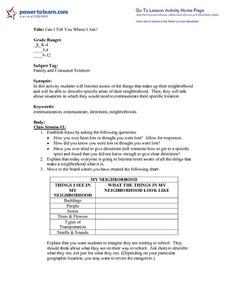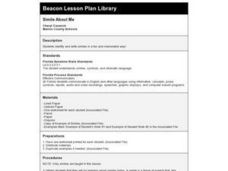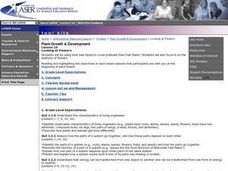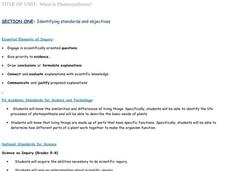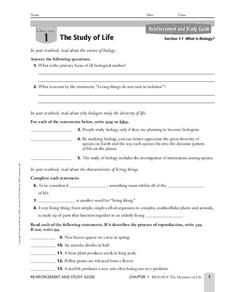Curated OER
What Did I Touch Today?
Second graders describe and adopt behaviors for health and safety. They explore what germs are and how they can make you sick. Through graphing activities, 2nd graders examine the way germs travel and what they can do to prevent the...
Curated OER
Getting a Handle on Your Bee
Middle schoolers observe dried bees, carefully glue them to toothpicks, and use them for cross pollinating their Brassica plants. They also describe reasons why two similar investigations can produce different results. Finally,...
Curated OER
Can I Tell You Where I am?
Students participate in a lesson that is concerned with the factors of describing a neighborhood. They follow a set of target questions in order to obtain information about individual neighborhoods. The information is used The write...
Curated OER
Adjectives
Students list adjectives to describe Anakin, his cloak and the mood of the poster to write an adjective-rich description. They then sort the adjectives into categories of what they describe: people, places, or things.
Curated OER
Pio, Pio, Que Frio
Students investigate the characteristics of living things. They determine that different organisms have different needs and describe and compare them. They draw and verbally respond about their favorite animal.
Curated OER
Penguins Marching in Your Classroom
Sixth graders examine how penguins adapt to their Antarctic environment. Once they locate Antarctica on a map, they describe its characteristics and differences from other continents. After describing how penguins differ from more...
Curated OER
Outdoor Survival
Students are introduced to basic outdoor survival concepts. They identify the seven basic needs for survival. Students describe the symptoms and treatment for frostbite and hypothermia. They compare and contrast the value of different...
Curated OER
Biodiversity
Students complete activities to study the importance of biodiversity. In this biodiversity lesson, students find images to categorize into organism groups and illustrate their interconnections. Students use measurement tools to study a...
Curated OER
Where Do Your Veggies Grow?
First graders investigate the origins of vegetables. In this Science lesson, 1st graders identify where fruits and vegetables come from. Students describe how people utilize plants.
Curated OER
Dead Trees Alive! Nature Notebook
In this tree worksheet, students find a dead tree or rotting log, describe it and look for signs of living things near it and all animals they find below it.
Curated OER
Texture Adventure
First graders identify and explore items around the classroom. In this textures lesson, 1st graders discuss different kinds of textures. Students explore the classroom and find at least two different textures to describe and draw.
Curated OER
Simile About Me
Students are introduced to similes and read various examples. Then students write their own similes to describe themselves and share them with the rest of the class.
Curated OER
Animal and People Habitats
Students examine how animals create a unique space in which they can live. Students read a poem about animals' habitats discuss the habitats. They draw a space of their own and write a poem that describes their habitat.
Curated OER
Looking at Flowers
Young scholars use their bee sticks to cross-pollinate their Fast Plants and also focus in on the anatomy of flowers. They analyze how the parts of a system go together, and how these parts depend on each other. Finally, students...
Curated OER
Sensory Descriptors
Students feel items in a bucket and describe them using descriptive words. In this sensory descriptive lesson plan, students use words such as smoothe, rough, and bumpy.
Curated OER
Acidity
Sixth graders describe the physical and chemical properties of acids. For this chemistry lesson, 6th graders test the acidity of different solutions. They identify acids and bases using the pH scale.
Curated OER
Oobleck
First graders explore Oobleck. They manipulate and observe the properties of Oobleck. Students discuss the differences between solids and liquids. They investigate Oobleck. Students write a sentence describing what they observed about...
Curated OER
Hollow Hilton
Pupils identify animals that depend on their environment for survival. They describe the relationship between living things. They draw or write an explanation of their findings.
Curated OER
Look Up - Birds
Students investigate the concept of birds. They identify five different types of birds and name the characteristics that make them different than other living things. Students also name the different parts of the bird and how they are...
Curated OER
Natural Resource Awareness
Seventh graders design a collage that shows natural resources or things made from natural resources. They discuss the collages and decide how they use natural resources at home and school. They listen to a read aloud of a Native American...
Curated OER
What is Matter?
Sixth graders are read Goodnight Moon. They discuss the different kinds of
matter mentioned in the story. Students describe each item
they remember, they are encouraged to observe that some things are
made of smaller pieces, different...
Curated OER
What is Photosynthesis?
Students investigate the similarities and differences of living things. Specifically, students will be able to identify the life processes of photosynthesis and describe the basic needs of plants.
Curated OER
What is Biology?
In this science of biology instructional activity, students will review the concepts relating to biology including the characteristics of living things, the process of reproduction, adaptations, and evolution. This instructional activity...
Curated OER
Similes and Metaphors Information
In this similes and metaphors worksheet, students write a descriptive practice paragraph in which they describe a place, idea, person, event, or concept without telling what the subject of the paragraph is. Students then pair up to...


